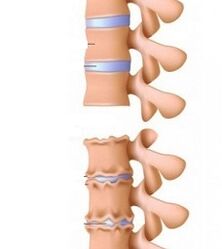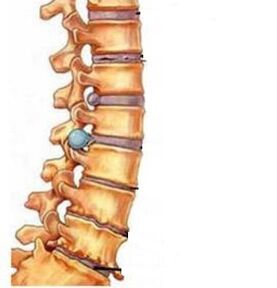
Osteochondrosis of the cervical region is a disease associated with violations of metabolic processes, namely the accumulation of salts in the blood and lymph, which leads to the pathological transformation of the structure of intervertebral discs, vertebrae and joints between the vertebrae.The loss of the elasticity cartilage fabric contributes to the displacement of vertebrae, artery clamps and other dystrophic changes.
Due to the deformation of the joints, the height of the intervertebral discs decreases.It should be noted that in the cervical region the beads are located closer to one another than in other parts of the spine, and therefore, the discs are in a healthy condition.
Osteophytes (bone growths) form on the sides of the vertebrae, which irritate the muscles, causing their tension.Osteophytes also squeeze the roots of the spinal nerve, vertebral arteries and small blood vessels, from which brain cells do not receive enough blood.The brain degrades and dies.
From the frequency of the appearance of second -place neck osteochondrosis behind the middle cross.The first signs of the disease can appear at school age, after 25 years in one form or another this disease is observed in almost everyone.In women aged 45-65, additional symptoms appear - making sensations in the hands area during sleep against the background of pain and numbness.
Reasons for the development of osteochondrosis of the neck
Hippodynamia - a sedentary, sedentary lifestyle, mainly leads to cervical osteochondrosis.As a rule, they suffer from people whose work involves a long stay in one position: computer work, office workers, drivers, etc.Osteochondrosis should be expected if a person has improper behavior or he keeps the body in an abnormal position for a long time, for example, keeps a cell phone or shoulder phone.

Incorrect stay on the computer leads to cervical osteochondrosis!
Excessive stress of the back and neck cause excessive physical activity for the body, for example, lifting weights.The same effect deals with physical exercise with wrong performance.
The degeneration and dystrophy of the cervical region is due to constant nerve tension and stress, prolonged or temporary hypothermia of the body, unbalanced, weak, infections.
The increased risk group belongs to people with an inherited predisposition to osteochondrosis, with defects in the development of the spine, with a traumatic spine or back in general.Risk is chronic diseases of the skeletal muscle system (rheumatism, scoliosis, systemic lupus erythematosis).The disease is favored by hormonal imbalance, overweight, flat legs, progressive discos.
The main symptoms of cervical osteochondrosis and the factors that cause them
The main symptom of osteochondrosis is pain in the occipital segment of the neck.If the nerve roots are affected, the pain extends to the shoulders, forearms.With muscle spasm and damaged blood circulation, the pain is felt in the ears, eyes, teeth, forehead.It can give to the shoulder blade, chest, gall bladder, lower back.Painful sensations also increase with minimal loads, long lowers, tendencies or curves.Pain essentially manifests after sleep and disappears if you develop muscle.Frequent departments occur - sharp pain, accompanied by muscle strengthening and difficulty moving.

The numbness of the arms and legs occurs, it burns and the tingling is felt.The roots damaged with the engine nerves weaken the strength of the limb muscles.Blood pressure can grow, take the heart.
The cervical department with sophisticated intervertebral discs, osteophytes in the beads and influenced the intervertebral joints and crumbs if you suddenly discard it or turn your head.
The strained arteries and the deteriorating blood supply to the occipital fraction of the brain and cerebellum leads to neurotic disorders, which manifest in the form of irritability, anxiety, mood variability, dissatisfaction and insomnia.There are outbursts of anger, nervous anorexia, fear, desire.
For the same reason, tongue and fingertips are numb, a voice of voice, hearing and sight decreases, rust in the ears, darkened in the eyes, dimming occurs.Almost always, especially in women, persistent, even stronger headaches are observed if you turn the neck severely.
The affected vestibular apparatus leads to disorientation in space, damaged coordination, dizziness and nausea and vomiting associated with these phenomena.
Stages of development of osteochondrosis of the neck
Cervical osteochondrosis develops stadialy, each of the stages has its own clinical appearance.
In the first (paracreen) stage, the muscles are slightly tense, the pain is weak, when it turns or bends the head, it can increase.The rapid fatigue of the spinal and lumbar muscles is characteristic.At this stage, the disease is treated without medication.

The second stage occurs with a decrease in the height of the intervertebral disc and pinching of nerve endings.In addition to the neck, shoulder and hand hurt.Rapid fatigue, headache, distraction appears, work is difficult and performance is reduced.
The third stage marks the formation of intervertebral disc herniations.Then the wrist muscles are weakening and numb, the constant pain gives the arm or shoulder.Overall weakness is associated with dizziness.
In the fourth stage, vertebral artery is affected, the destroyed intervertebral disc is replaced with connective tissue.Coordination is disturbed, severe dizziness and noise in the ear are disturbed.
Symptoms of cervical osteochondrosis by type and vertebrae affected
Some types of cervical osteochondrosis are distinguished.
- Novice syndrome- Due to the tip of the nerve endings, high intensity pain, in addition to the neck, covers the shoulder, forearm, felt in the shoulder blade and the lower back.
- Vail artery syndrome- It is distinguished by a pulsating headache in the back of the head or temple.
- Irritant - Reflex Syndrome- The pain of burning in the neck and nape gives the chest and shoulder, when you turn your head, cough, in a dream that intensifies.
- Cardiac syndromeIt occurs due to damage to the spine of the diaphragmatic nerve or large chest muscles.Pressing pains appear in the heart of the heart, they last for several hours, when they move or take a deep breath, they intensify.
The loss of various cervical vertebrae is manifested by its symptoms.
A wonderful 1st and 2nd cervical vertebra (CI-II) causes pain in the nave and crown.Powerful nerve root (C3) leads to neck numbness, tongue sensitivity decreases, speaking worries.If the nerve pole of C4 is affected, the collarbone or shoulder is numb, breathing is disturbed, heart pain appears.Distribution of the 5th department vertebra has a violation of the sensitivity of the arms and legs and pain in the shoulder.Compression of the roots of C6 and C7 is associated with pain in the neck, forearm, blade, lower and back spine in general, weakening of the sensitivity of the hands and fingers.The affected nerve root of C8 provokes pain in the neck, spine, elbow and lower extremities.The small fingers are numb in their hands, the sensitivity of the skin decreases to zero.Due to the weakening of the blood flow, the legs and hands become cyanotic.
Diagnosis of cervical osteochondrosis
The diagnosis of neck osteochondrosis begins with gathering information about a person's lifestyle and his work, analysis of complaints and symptoms, it should also be revealed if this disease was for relatives.
Then an external examination of the back and neck is performed in different positions, which allows you to see if there is a violation of behavior.Palpation of painful areas reveals the degree of pain and tension of muscles and beads.
The main role in the diagnosis is played by instrumental research methods.
The longest instrumental method - X -Rray allows you to identify the overall condition of vertebrates and vertebrates, but in the later stages of the disease is ineffective.
Calculated tomography has much better diagnostic skills, but this method does not allow to make a complete idea of the presence and size of intervertebral hernia.It is not clear if there is a compression of spinal cord hernia.
The highest efficiency is indicated by the image of magnetic resonance (MRI).Not only the bone formations are perfectly tracked, but also other important structural elements of the spine: intervertebral discs, hernia, their parameters and the manner of their development.It is clear to which condition the soft fabrics are.Double ultrasound scan of vertebral vessels allows you to make an idea for their structure, patent for blood flow and its speed, violations and abnormalities of the walls.
By creating damaged intervertebral discs and the degree of their violation, you can prescribe an adequate treatment.Otherwise, not only osteochondrosis will progress, but different complications are possible.
Complications for cervical osteochondrosis
Complications for cervical osteochondrosis arise due to the effect on:
- discs, nerves, nerve endings, plexuse (neurological disease);
- spinal cord;
- brain
Closely placed nerve endings and blood vessels in the slightest concern are compressed, which, in turn, disrupt cerebral circulation, provoke a number of disorders and diseases: migraine, hypertension, heart damage, hearing problems, vision and attention.
The neglected osteochondrosis of the cervix is fraught with the development of vertebral artery syndrome, brain ischemia, spinal cord and other deadly pathologies.Growths in the beads (radiculopathy) lead to complete or partial loss of body sensitivity and mobility.Squeezing the spinal cord causes a fatal result.
The treatment of osteochondrosis of the spine
With degenerative lesions of the intervertebral discs, I use different methods of treatment depending on symptoms.
Drug treatment of cervical osteochondrosis
A specialist in osteochondrosis is a neuropathologist, a specialist directly on the back is a vertebologist.
Drug treatment is aimed at eliminating pain, relieving inflammation, improving blood circulation, body support as a whole.
The most disturbing syndrome -severe, sometimes unbearable pain, can be removed using non -steroidal anti -inflammatory drugs (NSAIDs).The same drugs relieve aseptic inflammation and swelling of the roots of damaged nerves.If the pain is poor, it is enough to get an analgesic.
You should know that most NSAIDs adversely affect the gastric mucosa, so it is not recommended to take them for a long time.
Anesthesia and simultaneously heat the affected areas can be ointments and gel.A piece of pepper can be applied to the injured site, but its effect is limited to the heat of the inflamed area.
Diuretics and plant infusions are suitable for combating edema.
In the treatment of cervical osteochondrosis, vitamins B (B1, B6, B12) are certainly used.Vitamins of this group improve metabolic processes in nerve tissue.Effective both oral tablets and solutions for intramuscular administration are effective, but injection administration is painful and there may be complications.
The most important therapeutic task is to reset the cartilage to the intervertebral disc.Is selected using chondroprotectors.It should be borne in mind that all these medicines are biologically active additives with vague effectiveness.
The characteristics of the pathology require the use of medicines that improve blood properties, blood flow to the brain and the nutrition of damaged nerve roots.
Muscle jumps can be removed using muscle relaxants.
Medications introduced into the body through intramuscular injection affect the nerve endings more quickly.The blocks are performed directly in the affected area, which immediately provides the required effect.
The duration of taking certain medicines depends on the stage of osteochondrosis, patient complaints and his related diseases.
Physiotherapeutic procedures

Treatment of cervical osteochondrosis without failure includes physiotherapeutic procedures.
Under the influence of electricity (electrophoresis), the drug immediately enters the destruction site.
The effect of ultrasound anesthesia, relieves inflammation, improves metabolic processes.Magnetotherapy relieves tissue edema and thus reduces pain.Laser therapy has an anti -inflammatory effect and improves blood circulation.
To improve blood supply to the brain, the massage of the cervical area is very useful.A special place in the treatment of cervical osteochondrosis is occupied by therapeutic exercises, especially if the number of limbs is observed.The patient's condition improves by improving blood circulation and reducing muscle stress.In the acute phase of the disease, gymnastics is not recommended, it should be done during healing.
If the conservative treatment does not give a positive result within 6 months, the pain does not pass and the damaged nerve roots do not restore, or manifest myelopathy, you can turn to surgical intervention.
With the non -bonded root cause of osteochondrosis of the cervical region, and this is in most cases a sedentary, sedentary lifestyle, drug treatment will have a short -term effect.For irreversible recovery, regular physical activity and food that does not contribute to the development of the disease are necessary.
Treatment of cervical osteochondrosis by popular methods
Products of plant and animal origin are used for the treatment of cervical osteochondrosis.They can be inserted inside and applied outside.

For internal use, you can prepare an infusion of celery, a bay of 4-5 g of plants with a liter of boiling water and insisting for 2-4 hours.
The compresses can be prepared by:
- honey (1-2 teaspoons) and mummy;Heat, wear a warm wool fabric and glue it to the affected area of the spine at night;
- shit;Grate the root in a grater, heat it slightly, wrap it in the gauze to be applied to a sore place and tie it to a warm cloth to maintain heat;
- HAIL(Rinse the leaves with hot water, apply in a sore spot and wrap it with a bandage when the leaves dry, replace with new ones).
For friction, you can use chamomile and oil (preferably olive), although sunflower is also suitable.30 g of flowers and 0.5 liters of oil over low heat to boil, insist 2 days, strain and apply to injured areas.In chamomile you can add Wort, Calendula, St. John's Celandine.
For the same purposes, you can prepare a decoction of dandelion, birch buds, mint, coriander leaves (combine the mixture with steep boiling water in a ratio of 1: 1, insist one hour, after rubbing, apply a heat band).A tool to rub from Calendula (50 g of flowers pour 0.5 liters of vodka, insist 2 weeks).
To get rid of the symptoms of osteochondrosis, leeches - hirudotherapy have long been used.In the early stages, 6 sessions are enough.But caterpillars can cause allergies and then, of course, treatment ceases.
Popular remedies show effectiveness only at the initial stage of the disease, if the disease progresses, the basis of treatment should be medication methods.
Prevention of cervical back osteochondrosis
The main preventive measure from this disease is physical activity (including walks, swimming) and gymnastics (aerobics, yoga), but you cannot raise excessive severity.Bodybuilding can provoke the extension of the cervical disk.Support to the right weight level is fraught with this measure.When you sit down, you need to monitor the behavior, after every hour take five -minute vacation, cook your neck every 2 hours.But sharp head movements should be avoided.If you regularly massage, it will be possible to prevent the development of excess muscle tension.

Food should be rich in vitamins, minerals (calcium, magnesium) and other useful substances.Porridge, eggs, legumes, mushrooms, low meat with little swelling (beef, chicken, rabbit), caskets (fish, crab, seafood, lobster, mussels), milk products (milk, cottage cheese), fresh bow fruits, arc, arc, bow, bow.
If neck osteochondrosis is associated with atherosclerosis, it is necessary to limit the use of cholesterol -containing products - animal fats, fatty meat, fatty milk products.Limited consumption products also include flour, sugar, salt products.
Alcohol is harmful to this, falling into the bloodstream, it destroys cells, which exacerbates the already poor blood flow.Smoking also falls under stops.
To protect osteochondrosis, stress must be avoided.It becomes a healthy sleep to prevent the development of the disease.You need to sleep on a solid mattress and a low pillow, the neck should not bend more than 15 °.
Hot shower, a sauna and a bath help to remove neck spasms.
If there is a predisposition to osteochondrosis, the doctor should be shown occasionally.



















